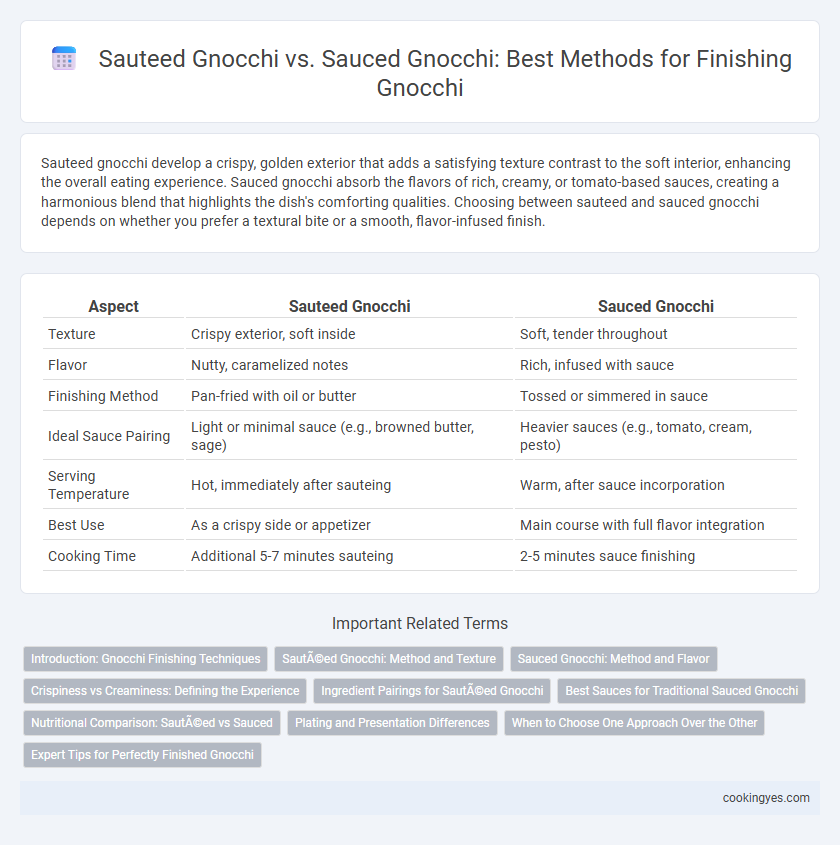Sauteed gnocchi develop a crispy, golden exterior that adds a satisfying texture contrast to the soft interior, enhancing the overall eating experience. Sauced gnocchi absorb the flavors of rich, creamy, or tomato-based sauces, creating a harmonious blend that highlights the dish's comforting qualities. Choosing between sauteed and sauced gnocchi depends on whether you prefer a textural bite or a smooth, flavor-infused finish.
Table of Comparison
| Aspect | Sauteed Gnocchi | Sauced Gnocchi |
|---|---|---|
| Texture | Crispy exterior, soft inside | Soft, tender throughout |
| Flavor | Nutty, caramelized notes | Rich, infused with sauce |
| Finishing Method | Pan-fried with oil or butter | Tossed or simmered in sauce |
| Ideal Sauce Pairing | Light or minimal sauce (e.g., browned butter, sage) | Heavier sauces (e.g., tomato, cream, pesto) |
| Serving Temperature | Hot, immediately after sauteing | Warm, after sauce incorporation |
| Best Use | As a crispy side or appetizer | Main course with full flavor integration |
| Cooking Time | Additional 5-7 minutes sauteing | 2-5 minutes sauce finishing |
Introduction: Gnocchi Finishing Techniques
Sauteed gnocchi offers a crispy, golden exterior that enhances texture and adds rich, toasted flavors, making it a popular finishing method. Sauced gnocchi, on the other hand, retains its soft, pillowy consistency while absorbing the nuances of creamy, tomato, or pesto sauces for a harmonious dish. Choosing between sauteing and saucing depends on desired texture and flavor intensity in the final presentation.
Sautéed Gnocchi: Method and Texture
Sauteed gnocchi involves pan-frying boiled dumplings in butter or oil until golden brown and crispy on the outside while maintaining a soft, pillowy interior. This method enhances texture by creating a contrast between the crunchy exterior and tender center, adding depth to each bite. The process also develops rich, caramelized flavors that elevate the simple potato base, making it a preferred finishing technique for texture-focused dishes.
Sauced Gnocchi: Method and Flavor
Sauced gnocchi is finished by gently folding the delicate potato dumplings into a warm, flavorful sauce, ensuring each piece is coated evenly to enhance texture and taste. This method infuses the gnocchi with rich aromas from ingredients like tomato, cream, or pesto, creating a harmonious blend that highlights the gnocchi's soft, pillowy consistency. Proper simmering in sauce allows the gnocchi to absorb subtle seasoning nuances, resulting in a deeply satisfying dish with balanced moisture and richness.
Crispiness vs Creaminess: Defining the Experience
Sauteed gnocchi delivers a golden, crispy exterior that enhances texture and creates a satisfying bite, while sauced gnocchi offers a rich, creamy mouthfeel that intensifies flavor absorption. The contrast between sauteed gnocchi's crunch and sauced gnocchi's smoothness defines the core sensory experience, catering to contrasting preferences for texture and taste. Crispness adds a savory dimension through caramelization, whereas creaminess emphasizes the decadent qualities of butter, cheese, and rich sauces.
Ingredient Pairings for Sautéed Gnocchi
Sauteed gnocchi develop a crispy, golden exterior that pairs perfectly with robust ingredients like caramelized onions, garlic, fresh sage, and smoked pancetta, enhancing their rich, savory flavor profile. Ingredients such as wilted spinach, sun-dried tomatoes, and toasted pine nuts add textural contrast and complementary earthy notes, making sauteed gnocchi an ideal base for bold, aromatic pairings. Using sauteed gnocchi with ingredients that offer crunch and acidity balances their pillowy texture and elevates the overall dish.
Best Sauces for Traditional Sauced Gnocchi
Traditional sauced gnocchi pairs exceptionally well with rich, flavorful sauces such as classic tomato basil, creamy gorgonzola, or hearty ragu to enhance its soft texture. These sauces cling perfectly to the pillowy dumplings, allowing each bite to deliver a balanced combination of taste and moisture. Sauteed gnocchi, by contrast, offers a crispy exterior that pairs better with lighter or simpler finishes, whereas traditional sauced gnocchi thrives with robust, well-seasoned sauces.
Nutritional Comparison: Sautéed vs Sauced
Sauteed gnocchi typically contains fewer calories and less fat compared to sauced gnocchi, as sauteing primarily uses minimal oil or butter, whereas sauces often incorporate cream, cheese, or oil-based ingredients that increase calorie density. Sauced gnocchi may provide higher sodium levels due to added salt and preservatives found in tomato or cream sauces. Both preparations supply carbohydrates from the gnocchi base, but sauteed versions maintain a leaner nutritional profile ideal for those managing calorie intake.
Plating and Presentation Differences
Sauteed gnocchi offers a golden, crispy exterior that enhances visual appeal with a textured, rustic finish, ideal for plating that highlights contrast and dimension. Sauced gnocchi presents a glossy, uniformly coated appearance, emphasizing smoothness and color vibrancy, which works well for elegant, sauce-focused presentations. The choice between sauteed and sauced gnocchi significantly influences the dish's visual texture, shine, and overall plating style.
When to Choose One Approach Over the Other
Sauteed gnocchi offers a crispy, golden exterior with a tender interior, ideal when seeking texture contrast that enhances dishes with simple or light sauces. Sauced gnocchi is preferable for rich, creamy, or heavily spiced sauces, allowing the dumplings to absorb flavors for a cohesive bite. Opt for sauteing when presentation and texture are key; select saucing to emphasize depth and integration of flavor.
Expert Tips for Perfectly Finished Gnocchi
Sauteed gnocchi develop a crispy, golden exterior that contrasts wonderfully with their pillowy interior, enhancing texture and flavor complexity. Sauced gnocchi absorb rich, velvety sauces, creating a harmonious blend that emphasizes the dumplings' tenderness and the sauce's depth. Experts recommend lightly sauteing gnocchi before tossing them in sauce to achieve the best balance of crispness and saucy richness for a perfectly finished dish.
Sautéed gnocchi vs sauced gnocchi for finishing Infographic

 cookingyes.com
cookingyes.com